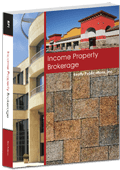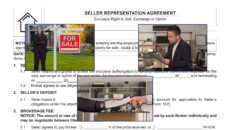Investors all want to know the same thing: “Is this property going to pay off?”
Any agent can provide an authoritative and data-driven answer using two simple formulas:
- the capitalization rate (cap rate); and
- the net income multiplier (NIM).
Related article:
Capitalization rates, explained
The cap rate is pure profit — the amount of money remaining after all of the owner’s property expenses are deducted from the gross income produced by the property — expressed as a rate, or percentage. Most real estate investors will have a specific cap rate in mind when shopping for income-producing property. This rate may be realistic or not, depending on the current market. [See RPI e-book Income Property Brokerage Chapter 4]
To find a property’s cap rate, a buyer’s agent needs the following data:
- gross operating income (GOI) from the property (the rent amounts paid by the building’s current tenants and the scheduled rent amounts for vacant units);
- property operating expenses (taxes, maintenance and repairs cost, etc.); and
- the purchase price for the property.
Having obtained the above information, the agent calculates the net operating income (NOI) of the property by subtracting all property expenses from the GOI:
GOI – operating expenses = NOI
Next, the agent determines the cap rate by dividing the NOI by the purchase price:
NOI ÷ purchase price = cap rate
Once the agent has found the cap rate and presented it to their buyer, the buyer can decide if it is high enough and whether the cost of purchasing the property will meeting their objectives in owning an income producing property. If the cap rate from the listing price seems too low, the buyer’s agent can use the inverse of the cap rate formula to find a purchase price more consistent with their buyer’s desired cap rate.
First, find the NIM — this is the reciprocal of the cap rate. Since a cap rate is expressed as a percentage, or fraction of 100, this can be done by dividing 1 by the cap rate:
1 ÷ cap rate = NIM
Next, find the buyer’s desired purchase price by multiplying the NOI by the NIM:
NOI × NIM = purchase price
What the buyer wishes the profit generated from the property to be and what can realistically be anticipated may be two different things. However, an agent who knows how to find a property’s cap rate and NIM can cut through a jungle of expenses and variables to show their buyer an investment property’s bottom line – in real numbers – in mere minutes.
Remember: knowledge is the key to success in today’s real estate market!
Related Video: Three Appraisal Approaches: Income Approach
Click here for more information on this topic.
Other buyer considerations
The cap rate does not reflect every aspect an investor buyer needs to consider when setting the maximum price they will pay. Application of a cap rate formula alone does not account for:
- required renovation and rehabilitation of the property (which requires additional capital beyond the purchase price to eliminate the obsolescence);
- the cost of hiring a property manager and of other services needed to operate the property (when not included as an operating expense);
- a mortgage with an interest rate exceeding the combined rate of inflation and real return on investment used to set the cap rate; and
- a final/balloon payment in a mortgage.
Thus, a buyer purchasing an income-producing property subject to an existing mortgage or funded by a new mortgage needs to set the cap rate higher than the interest rate on the mortgage to justify the risk of loss. This spread covers items such as recovery of the investment or reserves for replacement, and risks presented by changes in demographic (tenant) demands.
Editor’s note — Any adjustable rate mortgage (ARM) or due-date financing presents a particularly troublesome risk of loss due solely to future increases in interest rates — which of course reduce property values.
Further, the primary source of funds for the owner’s payment of a purchase-assist mortgage is the property’s NOI. The NOI remaining after deducting the interest paid on the mortgage represents the earnings attributable to the buyer’s cash equity investment.
Thus, this remaining portion of NOI needs to produce a much higher percentage yield on the buyer’s leveraged equity investment (cash) to offset the risk of the buyer’s cash being subordinate to mortgage financing.
Risks inherent in the property: the primary category of risk
As is the case with any investment, purchasing income-producing property includes an amount of risk that some or all the capital (cash and borrowed mortgage funds) will be lost.
Thus, the prudent investor asks: how do you include this risk (called a risk premium) in the cap rate, in addition to the real rate of return and the inflation rate?
There are two types of risk to consider when determining the risk premium rate to be included in cap rates:
- risks inherent in the property (the primary category of risk); and
- risks due to human and other exterior activity (the secondary category of risk).
The primary category of risk considers the physical improvements on the property, including their deterioration and declining usefulness through aging, called physical obsolescence.
Physical obsolescence is also labeled depreciation for tax accounting purposes. Depreciation provides for a return of capital (capital recovery) over the remaining economic life of the improvements before the land value exceeds the value of the property’s income, called economic obsolescence.
Risks due to human and exterior activity: the secondary category of risk
The secondary category of risk includes the “human” and exterior influences on the property’s value. These risks include:
- the creditworthiness and level of employment diversity in current tenants, an employer issue;
- the coming expiration of current leases, which are preferably staggered, a management issue [See RPI Form 352-1];
- competition from nearby, similar properties (existing and future construction), a market issue;
- a history of crime committed on or near the property, a security issue [See RPI Form 321];
- long-term income and wealth changes in the area surrounding the property, a demographic issue; and
- changes in zoning, retrofitting, habitability and fire ordinances or regulations, a political issue. [See RPI Form 185]
Want to learn more about this topic? Click an image below to download the RPI book cited in this article.
This article was originally posted [August, 2012 of Know the bottom line for investment properties], and has been updated.















